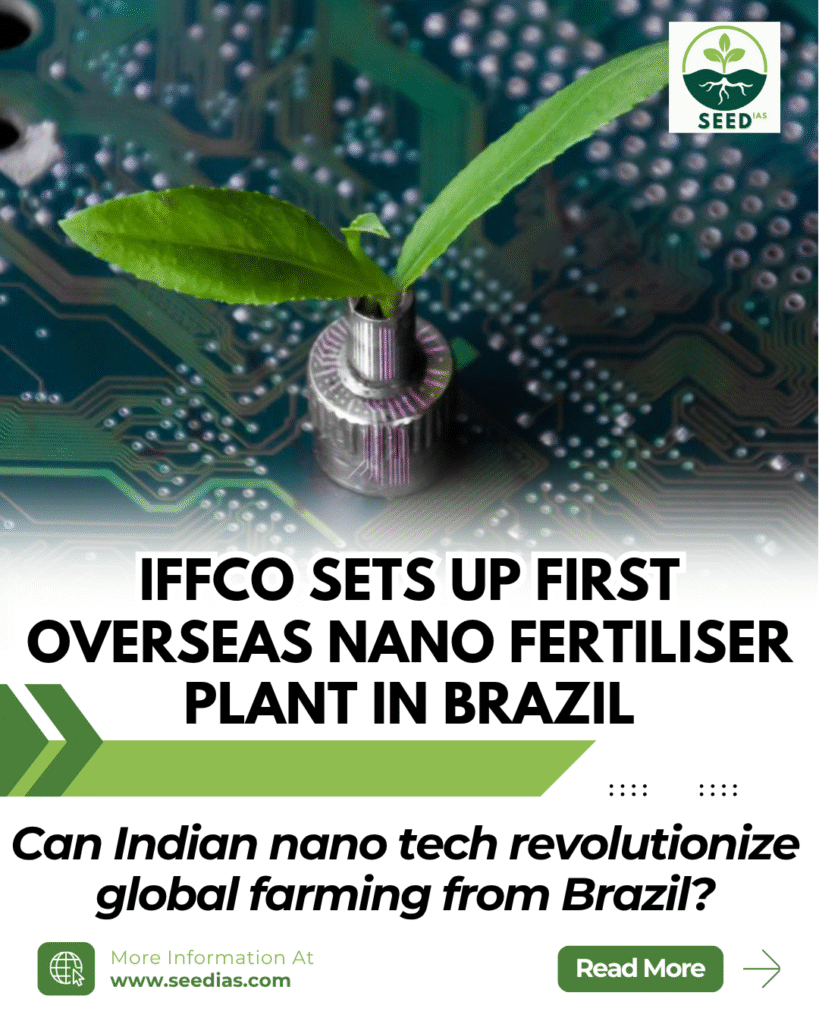Why in NEWS
IFFCO is establishing its first international nano fertiliser plant in Curitiba, Brazil, through a joint venture. This move follows successful nano fertiliser exports to over 40 countries, including the US and Nepal.
Key Concepts & Terms
| Term | Explanation |
|---|---|
| Nano Fertiliser | Fertilisers enhanced with nanoparticles (1–100 nm) for controlled nutrient release |
| Nano Urea / Nano DAP | Highly concentrated liquid nano formulations of urea and diammonium phosphate |
| Chitosan | Natural polymer derived from crustaceans, used in organic nanofertiliser coatings |
| Nanoporous Material | Substances with nanoscale pores for slow, steady nutrient delivery to plants |
| IFFCO | Indian Farmers Fertiliser Cooperative, one of the world’s largest cooperatives |
News Details
IFFCO’s Brazil plant will produce 4.5 million litres of nano fertilisers annually.
Brazilian crops like corn, soybean, and sugarcane have shown:
- 20% reduction in urea and DAP use
- 10% yield boost in corn/soybean
- 7% increase in sugarcane output
Growing farmer interest in nano fertilisers is rooted in higher yields with lower chemical use, aligning with sustainable farming goals.
Types of Nano Fertilisers
| Type | Functionality |
|---|---|
| Nanoscale Coating Fertilisers | Use nano-coatings for controlled nutrient release |
| Nanoscale Additive Fertilisers | Nutrients attached to nano-sized carriers for gradual absorption |
| Nanoporous Materials | Allow slow and sustained nutrient supply to plant roots |
Nano Fertiliser Adoption in India
| Year | Product | Units Sold (FY25) |
|---|---|---|
| 2021 | Nano Urea | 26.5 million bottles (Nano Urea Plus) |
| 2023 | Nano DAP | 9.7 million bottles |
Future plans include Nano Zinc and Nano Copper.
Why Nano Fertilisers Matter for India
| Aspect | Relevance |
|---|---|
| Fiscal Pressure | Fertiliser subsidies hit ₹1.67 lakh crore in FY26, straining budgets |
| Import Reduction | Nano fertilisers reduce dependence on imported urea and DAP |
| Nutrient Efficiency | 500 ml nano urea equals 45 kg of traditional urea in plant absorption |
Challenges in Adoption
| Challenge | Concern |
|---|---|
| Farmer Awareness | Resistance due to lack of understanding or trust |
| Scientific Skepticism | Government audit shows 25–50% variation in nitrogen-saving efficacy |
| Environmental Risk | Potential nanoparticle accumulation in food chain and ecosystems |
About IFFCO
| Feature | Description |
|---|---|
| Founded | 1967, New Delhi |
| Network | Over 36,000 member cooperatives serving 50+ million farmers |
| Domestic Presence | 5 fertiliser plants and 20+ state offices across India |
| Global Ventures | JIFCO (Jordan), OMIFCO (Oman), KIT (Dubai), ICS (Senegal) |
| Diversification | Rural telecom, general insurance |
In a Nutshell
Memory Code: “BRAZIL”
Boost in crop yields
Reduction in chemical usage
Awareness gap persists
Zinc and copper nano plans ahead
IFFCO’s global footprint grows
Liquid nano fertilisers go mainstream
Prelims Practice Questions
- Which Indian cooperative has set up its first overseas nano fertiliser plant in Brazil?
A) KRIBHCO
B) IFFCO
C) HAFED
D) NAFED - What is the equivalent of 500 ml of Nano Urea in terms of conventional urea?
A) 5 kg
B) 15 kg
C) 25 kg
D) 45 kg - Which of the following is an organic component used in nano fertilisers?
A) Titanium dioxide
B) Zinc oxide
C) Chitosan
D) Silica nanoparticles
Mains Practice Questions
- (GS-3 – Agriculture)
Evaluate the potential of nano fertilisers in reducing India’s fertiliser subsidy burden and environmental footprint. - (GS-2 – International Relations)
How does IFFCO’s venture into Brazil reflect India’s growing agricultural diplomacy and South-South cooperation?
Prelims Answer Key
| Qn | Answer | Explanation |
|---|---|---|
| 1 | B | IFFCO is the Indian Farmers Fertiliser Cooperative setting up the plant in Brazil |
| 2 | D | 500 ml of Nano Urea equals 45 kg of conventional urea |
| 3 | C | Chitosan is a natural biopolymer used as an organic coating material |
















